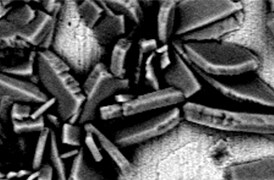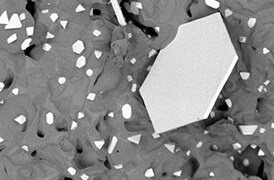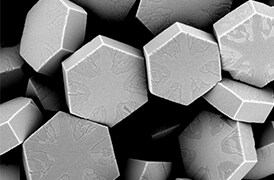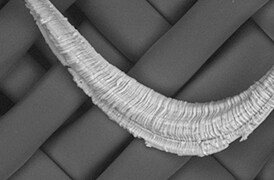Search Thermo Fisher Scientific

Materials science
X-Ray Photoelectron Spectroscopy
XPS surface analysis of materials ranging from metals to polymers.
As the demand for high-performance materials increases, so does the importance of surface engineering. The material’s surface is its point of interaction with the external environment and other materials, and will influence factors such as corrosion rates, catalytic activity, adhesive properties, wettability, contact potential, and failure mechanisms.
Surface modification can be used to alter or improve these characteristics; surface analysis is used to understand surface chemistry and investigate the efficacy of surface engineering. From non-stick cookware coatings to thin-film electronics and bio-active surfaces, X-ray photoelectron spectroscopy is one of the standard tools for surface characterization.
X-ray photoelectron spectroscopy (XPS), also known as electron spectroscopy for chemical analysis (ESCA), is a technique for analyzing a material’s surface chemistry. XPS can measure elemental composition as well as the chemical and electronic state of the atoms within a material.

XPS spectra are obtained by irradiating a solid surface with a beam of X-rays and measuring the kinetic energy of electrons that are emitted from the top 1-10 nm of the material. A photoelectron spectrum is recorded by counting ejected electrons over a range of kinetic energies. The energies and intensities of the photoelectron peaks enable identification and quantification of all surface elements (except hydrogen).
Surface characterization
The surface represents a discontinuity between one phase and another; the physical and chemical properties of the surface are, therefore, different from those of the bulk material. These differences affect the topmost atomic layer of the material to a large extent because a surface atom is not surrounded by atoms on all sides. This results in the surface atom having a bonding potential, which makes it more reactive than atoms in the bulk.

Single-instrument, multi-technique XPS workflow
When you look at your sample, do you wonder which analysis technique will get you all the pertinent information you need? Is the answer usually that no one single technique will give you everything you need? To fully understand materials, you need to be able to analyze them using multiple techniques. When you use a single-instrument, multi-technique workflow, you can better expose your sample’s properties by exploring it with a combination of many techniques, including XPS, ISS, REELS, UPS, and Raman. Learn how you can get on the fast track to comprehensive surface analysis.
Surface Properties
Surface analysis contributes to the understanding of each of these areas:
|
|

Periodic Table
Explore our information-packed knowledge base of elemental properties and XPS analysis.
Analysis Features
Explore the many applications of XPS analysis.
Webinars
Understanding XPS images and depth profiles with Avantage Software - Part 2
By watching the webinar, you will learn how to use the right tools to understand multi-level data sets, such as depth profiles and images.
Understanding Surface Chemistry with Avantage Software
This webinar is designed to offer training to current users of Avantage software and act as an introduction to those unfamiliar with it.
Surface Analysis of Thin Films
Explore a number of applications for thin film coating analysis including forensic studies, graphene, multi-layered glass, coated fabrics and photovoltaics.
Understanding Metal Surfaces and Oxides
XPS delivers chemical state information from the topmost nanometers of a sample surface, enabling you to measure passivation coatings, understand catalyst chemistries, and develop bio-compatibility coatings.
Multi-technique Surface Analysis and Cluster Ion Sample Cleaning
We present how a dual mode ion source can be used for multi-technique sample analysis, showing the importance of sample cleaning and how depth profiles can be performed.
Characterizing Polymers with XPS
This webinar covers the basics of X-ray photoelectron spectroscopy, with a special emphasis on how it can be used in the field of polymer surface analysis. X-ray photoelectron spectroscopy is a powerful technique for the chemical analysis of the surface of materials.
Webinars
Understanding XPS images and depth profiles with Avantage Software - Part 2
By watching the webinar, you will learn how to use the right tools to understand multi-level data sets, such as depth profiles and images.
Understanding Surface Chemistry with Avantage Software
This webinar is designed to offer training to current users of Avantage software and act as an introduction to those unfamiliar with it.
Surface Analysis of Thin Films
Explore a number of applications for thin film coating analysis including forensic studies, graphene, multi-layered glass, coated fabrics and photovoltaics.
Understanding Metal Surfaces and Oxides
XPS delivers chemical state information from the topmost nanometers of a sample surface, enabling you to measure passivation coatings, understand catalyst chemistries, and develop bio-compatibility coatings.
Multi-technique Surface Analysis and Cluster Ion Sample Cleaning
We present how a dual mode ion source can be used for multi-technique sample analysis, showing the importance of sample cleaning and how depth profiles can be performed.
Characterizing Polymers with XPS
This webinar covers the basics of X-ray photoelectron spectroscopy, with a special emphasis on how it can be used in the field of polymer surface analysis. X-ray photoelectron spectroscopy is a powerful technique for the chemical analysis of the surface of materials.

Control de proceso
La industria moderna exige un alto rendimiento con una calidad superior, un equilibrio que se mantiene a través de un control de procesos sólido. Las herramientas SEM y TEM con software de automatización exclusivo proporcionan información rápida y multiescala para la supervisión y la mejora de procesos.

Control de calidad
El control y garantía de calidad son esenciales en la industria moderna. Ofrecemos una gama de herramientas de EM y espectroscopía para el análisis multiescala y multimodal de defectos, lo que le permite tomar decisiones fiables e informadas para el control y la mejora de procesos.

Investigación sobre materiales fundamentales
Se investigan nuevos materiales a escalas cada vez más pequeñas para lograr el máximo control de sus propiedades físicas y químicas. La microscopía electrónica proporciona a los investigadores información clave sobre una amplia variedad de características materiales a escala nanométrica.

Pulcritud
Más que nunca, la fabricación moderna necesita componentes fiables y de calidad. Con la microscopía electrónica de barrido, el análisis de limpieza de las piezas se puede llevar a cabo internamente, lo que le proporciona una amplia gama de datos analíticos y acorta su ciclo de producción.

Investigación de baterías
El desarrollo de baterías se realiza mediante análisis multiescala con microCT, SEM y TEM, espectroscopía Raman, XPS y visualización y análisis 3D digital. Aprenda cómo este enfoque proporciona la información estructural y química necesaria para crear mejores baterías.

Investigación sobre metales
La producción eficaz de metales requiere un control preciso de las inclusiones y precipitados. Nuestras herramientas automatizadas pueden realizar varias tareas cruciales para el análisis de metales, incluyendo el recuento de nanopartículas, el análisis químico EDS y la preparación de muestras de TEM.

Investigación geológica
Las ciencias geológicas están basadas en la observación uniforme y precisa de múltiples escalas de características dentro de las muestras de roca. SEM-EDS, combinado con software de automatización, permite el análisis directo a gran escala de la composición de la textura y los minerales para la investigación de la petrología y la mineralogía.

Gas y petróleo
A medida que la demanda de petróleo y gas continúa, existe la necesidad constante de una extracción eficiente y eficaz de hidrocarburos. Thermo Fisher Scientific ofrece una amplia gama de soluciones de microscopía y espectroscopía para una gran variedad de aplicaciones de la ciencia del petróleo.

Nanopartículas
Los materiales tienen propiedades sustancialmente diferentes en la nanoescala y en la macroescala. Para estudiarlos, la instrumentación S/TEM se puede combinar con la espectroscopia de rayos X por dispersión de energía para obtener datos de resolución nanométrica, o incluso subnanométrica.

Estudios forenses
Los microrastros de las pruebas de las escenas del crimen se pueden analizar y comparar usando microscopía electrónica como parte de una investigación forense. Las muestras compatibles incluyen fragmentos de vidrio y pintura, marcas de herramientas, drogas, explosivos y residuos de armas de fuego.

Investigación sobre catálisis
Los catalizadores son cruciales para la mayoría de los procesos industriales modernos. Su eficacia depende de la composición microscópica y la morfología de las partículas catalíticas; EM con EDS es ideal para estudiar estas propiedades.

Fibras y filtros
El diámetro, la morfología y la densidad de las fibras sintéticas son parámetros clave que determinan la vida útil y la funcionalidad de un filtro. La microscopía electrónica de barrido (SEM) es la técnica ideal para investigar rápida y fácilmente estas características.

Materiales 2D
La investigación de materiales novedosos presta cada vez más atención a la estructura de materiales de baja dimensión. La microscopía electrónica de transmisión de barrido con corrección de sonda y monocromación permite la adquisición de imágenes de materiales bidimensionales de alta resolución.

Pruebas de materiales para automóviles
Todos los componentes de un vehículo moderno están diseñados para garantizar la máxima seguridad, eficacia y rendimiento. La caracterización detallada de materiales de automoción con microscopía electrónica y espectroscopía informa sobre decisiones cruciales sobre procesos, mejoras de productos y nuevos materiales.
Microelectronics
Oxides & Metals
Polymers
Routine Analysis
SnapMap
Tribology
Servicios de microscopía electrónica para
la ciencia de materiales
Para garantizar un rendimiento óptimo del sistema, le proporcionamos acceso a una red de expertos de primer nivel en servicios de campo, asistencia técnica y piezas de repuesto certificadas.




